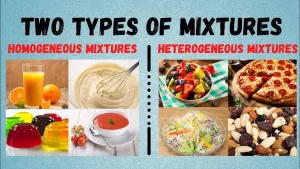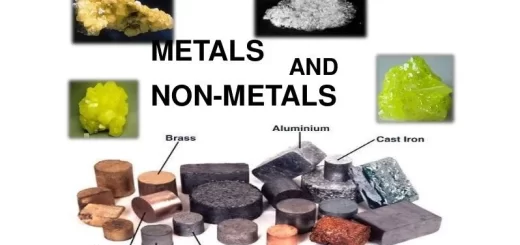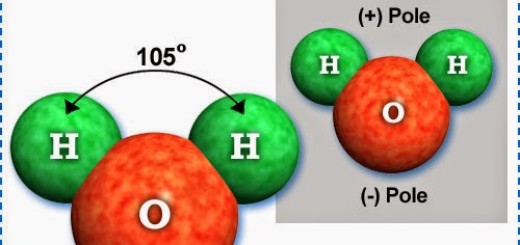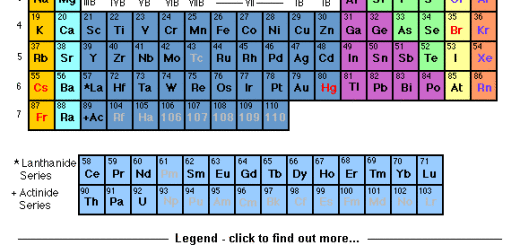Matter, Mixtures Types, Properties, Formation and Separation
Atmospheric air is a mixture of different gases such as oxygen, nitrogen, carbon dioxide, and water vapour, Solution is a special type of mixtures, where its components are mixed and interfere till you can not distinguish between its particles.
Types of matter
Matter can be classified into pure substances and mixtures, Pure substance is a substance that is made of only one type of identical particles such as distilled (pure) water, sugar, and baking soda.
A mixture is a substance that consists of more than one type of particles such as concrete, tomato sauce, and mineral water (a mixture of water and some useful minerals such as calcium and magnesium).
Both sugar and distilled water are considered pure substances because each of them is composed of only one type of identical particles, Both milk and concrete are considered mixtures because each of them consists of more than one type of particles.
Types of mixtures
There are many different types of mixtures, such as Solid-solid mixture, Liquid-liquid mixture, Solid-liquid mixture, Gaseous-Gaseous mixture, and Gaseous-liquid mixture.
- Solid-solid mixture consists of two or more different solid matter such as fruit salad and vegetable salad.
- The liquid-liquid mixture consists of two or more different liquids such as a mixture of vinegar and water, a mixture of oil and water, and a mixture of oil and vinegar (dressing of salad).
- The solid-liquid mixture consists of solid and liquid matter such as a mixture of sand and water, a mixture of salt and water.
- The gaseous-gaseous mixture consists of different gases such as atmospheric air which is a mixture of oxygen gas, nitrogen gas, carbon dioxide gas, and water vapour.
- The gaseous-liquid mixture consists of gaseous and liquid matter such as a mixture of soda water that is produced from dissolving carbon dioxide gas in sugar solution.
Mixtures can be separated by physical methods, such as filtration, distillation, or evaporation, without changing the chemical nature of the components. There are two main types of mixtures which are:
1. Homogeneous Mixtures
The individual components cannot be seen separately. They are distributed throughout the mixture.
Examples: Saltwater, sugar dissolved in water, air, alloys (like bronze), and vinegar.
2. Heterogeneous Mixtures
The individual components can be seen separately. They are not evenly distributed.
Examples: Oil and water, sand and water, pizza, trail mix, and granite.
Subtypes of Mixtures
- Solutions: A homogeneous mixture where one substance (solute) is dissolved in another (solvent), such as salt water, sugar water, and carbonated drinks.
- Colloids: A homogeneous mixture where particles are dispersed evenly but are larger than those in a solution. Examples: Milk, fog, and jelly.
- Suspensions: A heterogeneous mixture where particles are suspended in a liquid but settle over time. Examples: Muddy water, chalk in water, and orange juice with pulp.
Properties of mixtures
You can separate the tomato from the salad easily and eat it separately, The strawberry in the fruit salad keeps its taste and colour before and after mixing, You can add or remove the desired amount of vegetables in your vegetable soup, So, the properties of the mixture are:
- The components of the mixture do not join ( react ) together and can be separated easily.
- Each component in a mixture keeps its properties, so, the properties of a mixture are the same properties of its components.
- The components of the mixture can be mixed at any ratio.
A mixture of sand and iron fillings can be separated easily because the components of the mixture do not react together.
Formation of mixtures
A mixture can be formed by different methods such as shaking, stirring, and grinding, A mixture can be formed by mixing two or more different matters.
Where solid and liquid materials can be mixed by shaking or stirring such as a mixture of salt and water, liquid materials can be mixed by shaking or stirring such as a mixture of strawberry juice and banana juice, Solids materials can be mixed by shaking or grinding such as mixture of salt and pepper.
Separation of mixtures
The components of the mixture do not react together, so, they can be separated easily by simple methods such as :
- A magnet (Magnetic attraction) is used to separate the solid mixture that contains magnetic substances such as a mixture of sand and iron fillings.
- The filtration process is used to separate solid materials that are insoluble in water such as a mixture of sand (or mud) and water.
- The evaporation process is used to separate solid materials that are soluble in water such as a mixture of salty solutions.
- A separation funnel is used to separate liquid mixtures whose components do not mix together such as a mixture of oil and water.
A magnet can be used to separate iron fillings from sand because the magnet attracts the iron fillings only and separates them from the mixture, Filtration process is used to separate sand from sugary solution because the filtration process is used to separate the solid materials as sand that are insoluble in water.
You can subscribe to Science Online on YouTube from this link: Science Online
You can download Science Online application on Google Play from this link: Science Online Apps on Google Play
Matter, Properties & Kinds of molecules, Melting process and Vaporization process
Formation of the solution & factors affecting the solubility process




